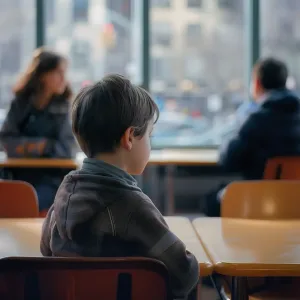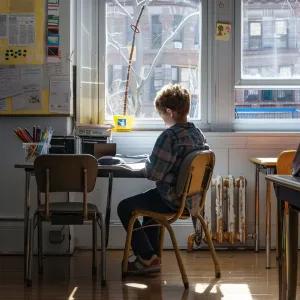A pendency order (the “stay-put” rule) keeps your child in the last agreed-upon placement—with the same services—while a special education dispute is pending in NYC. This blog will walk you through what pendency is, when it starts, how to invoke it, funding and duration rules, limits under recent case law, and practical steps to protect your child.
What Is Pendency (Stay-Put) and Why It Exists

Pendency—often called “stay-put”—is a legal protection under IDEA that automatically preserves a student’s “then-current educational placement” for the entire dispute, including mediation, impartial hearings, and appeals. Its purpose is to maintain stability and prevent a district from unilaterally changing services during litigation—functioning like an automatic injunction.
In NYC practice, pendency starts when a parent files a due-process complaint or a mediation request and continues until the parties settle or a final decision becomes final.
What Counts as the “Then-Current Educational Placement”?

Courts and state guidance generally define then-current placement as (a) the placement in the most recently implemented IEP, (b) the actual program the student was attending when the complaint was filed, or (c) a prior order (IHO/SRO/court) setting the program. Pendency can encompass services (e.g., speech therapy) and not just a classroom label, and a private-school program can be the pendency placement if it was part of the last agreed program or set by a prior order.
Importantly, stay-put guarantees the type and level of services—not necessarily the exact school building or teacher. Districts retain authority to determine the location for delivery, as long as they replicate the agreed program during pendency.
How to Invoke Pendency in NYC (Step-by-Step)
-
File a Due-Process Complaint (DPC) or Mediation Request
Pendency is triggered by filing. If the district does not voluntarily implement stay-put, you can ask the Impartial Hearing Officer (IHO) for a pendency order at (or even before) the hearing.
-
Request a Pendency Order from the IHO
In a pendency hearing, both sides argue what constitutes the last agreed program; the IHO issues a written order identifying the services/placement protected. NYC’s hearing materials explain this process for families.
-
Paper Trail & Precision Matter
Keep copies of IEPs, prior IHO/SRO orders, placement letters, provider logs, and send key communications by certified mail/email with read receipts. Precision evidence speeds pendency determinations. (Parent training guides emphasize meticulous record-keeping for pendency and enforcement.)
Who Pays—and How Long Does Pendency Last?
- Funding: The school district must continue paying for the pendency program, including private-school tuition or private services if those are part of the last agreed program. These payments do not have to be repaid even if parents ultimately lose the case on the merits.
- Duration: Pendency continues through all appeals and ends only at settlement or final decision (i.e., when the order is final and no longer appealable).
- Warning on unilateral changes: If parents unilaterally move to a different private school without DOE authorization or a pendency determination, pendency funding is at risk.
Limits and Recent Case Law You Should Know
- Not an IEP meeting decision: Pendency is a legal injunction, not a service a CSE can grant. It’s ordered by an IHO (and enforceable/appealable).
- Ventura de Paulino (2d Cir. 2020): Parents cannot unilaterally switch a child from a pendency-funded private school to a new private school during the dispute and automatically demand pendency funding for the new school. Districts may decide where the agreed program is delivered, and only “substantially similar” substitutions approved by an IHO may qualify.
- Recent NY SRO decisions: State Review Officers repeatedly affirm that IDEA and NY law require stay-put at the then-current placement unless the parties agree otherwise, and that pendency disputes focus on the existing program—not whether it’s appropriate. Recent decisions also clarify that rate disputes are generally outside a pendency order.
- Transitions (EI → CPSE; CPSE → Kindergarten): Special rules may apply during age-level transitions; DOE must maintain agreed services, though the school setting may change to reflect age/grade. Parent guides detail these nuances.
Pendency for Private-School Students and IESP Cases
For students enrolled in nonpublic schools, the pendency program may arise from an IESP (Individualized Education Services Program) or a prior IHO/SRO order. In such cases, the district must fund the last agreed-upon services until the case is resolved; pendency is an automatic injunction and does not depend on parents proving the merits at that stage. The inquiry is what the current program is, not whether it’s ideal.
Practical Guidance for NYC Parents (Do This Early)
1) Build a “Pendency Packet.”
Include the most recent implemented IEP, any IHO/SRO orders, progress reports, provider logs, and letters confirming the program/services your child actually receives. (This packet becomes the backbone of your stay-put claim.)
2) File Quickly—and in Writing.
Pendency attaches when you file (DPC or mediation). If your child’s services are being reduced or moved, act immediately so stay-put can lock the program in place during the dispute.
3) Ask the IHO for a Pendency Order if Needed.
If the district delays, explicitly request a pendency order from the IHO. NYC provides process details and separate implementation guidance (including new SupportHub workflows for orders issued after Jan 8, 2025).
4) Understand the Tradeoffs.
Pendency protects existing services but can delay the start of new services you’re requesting until the case is resolved—so weigh strategy with your attorney. (Parent training and advocacy materials highlight this “stability vs. progress” tradeoff.)
5) Consult an Attorney Early.
An experienced education lawyer NYC / NYC DOE due process lawyer helps define the then-current placement, prepares evidence for the pendency hearing, and navigates Ventura-era limits (e.g., “substantially similar” arguments). NYC hearing guides explain how IHOs and the DOE’s Implementation Unit carry out orders.
How a Lawyer Strengthens a Pendency Case
- Defines the pendency program precisely (services, frequency, delivery model) using IEPs, provider logs, and prior orders.
- Frames the record to show continuity (e.g., same program since prior IHO order) and rebut district attempts to narrow services.
- Argues Ventura-compliant positions, including “substantially similar” when necessary.
- Moves for immediate relief (pendency order) and follows through on implementation with NYC’s IU.
Conclusion
Pendency is your child’s legal seatbelt during a dispute: it preserves the current program and services while you and the district litigate or negotiate. In NYC, prompt filing, precise documentation, and experienced legal strategy ensure stay-put is triggered, defined correctly, and implemented quickly. If your child’s program is at risk—or the DOE is reducing services—invoke pendency and consult a qualified education lawyer NYC to secure stability now and a durable resolution next.
FAQs About Pendency Order Nyc
Q1: What is a pendency order in NYC special education?
A: It’s a stay-put order keeping a student in the last agreed placement—and services—during mediation, hearings, and appeals, to avoid disruption.
Q2: How do I trigger stay-put for my child in New York City?
A: File a due-process complaint or mediation request and, if needed, ask the IHO for a written pendency order defining the program and services.
Q3: Does pendency guarantee the same school building or teacher?
A: Not necessarily. Stay-put protects the type/level of services and program; the district can choose the site as long as the program is replicated.
Q4: Who pays for private-school tuition during pendency?
A: If the private program is the last agreed placement (or ordered previously), the district continues funding it through the dispute and appeals.
Q5: When does pendency end in NYC?
A: At settlement or when a final decision becomes final after appeals; until then, the current program and services remain in place.

